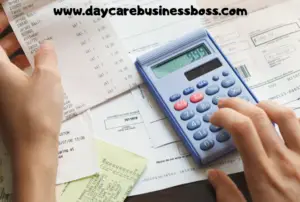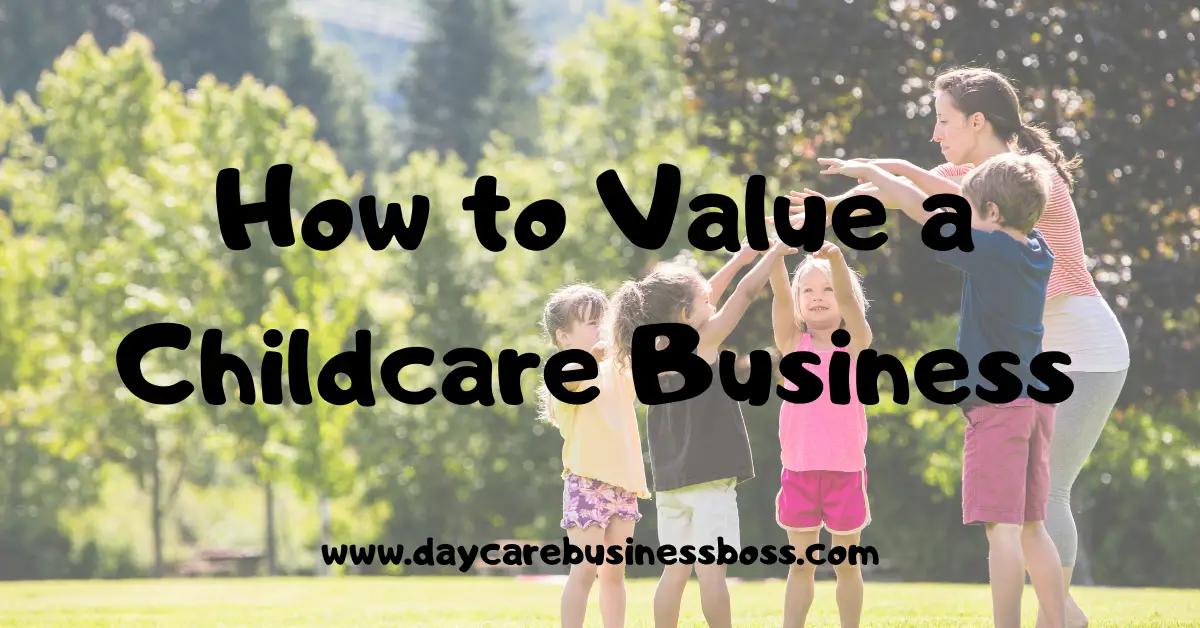Valuing a childcare business is important for negotiating a buying price between you as the new owner and the current owner. Based on the value calculations of the property in the daycare versus the profit potential and debts of the business, you can both agree on a buying price.
Value a daycare business by:
-
Adding up the valuable assets and property in the daycare.
-
Deducting debt and taxes the daycare owes.
-
Writing up a balance sheet.
-
Calculating return on investment.
Add the Value of Assets and Property
 Assets are what offer economic value to the business such as business savings, cash on hand, the tuition parents owe for children’s attendance, and any inventory and equipment you have on hand.
Assets are what offer economic value to the business such as business savings, cash on hand, the tuition parents owe for children’s attendance, and any inventory and equipment you have on hand.
First, check your cash register and add it with your business savings to get the cash equivalent portion of your asset calculations.
Then, add all the tuition that the parents are going to pay out to you over the coming year.
Finally, calculate the value of equipment and inventory, taking into account depreciation on equipment if applicable.
Cash Equivalents
Say that you have been in business for the past year. You just ended the last quarter of your first year with $50,000 in profit. You have a total of $20,000 in your business checking account and $30,000 in your business savings account.
Say that you have $500 in your register at the end of the week after dropping off cash tuition payments to the bank. This means that you have a total of $50,500 in the cash equivalents portion of your assets.
Tuition Received (Accounts Receivable)
When a potential daycare business buyer is looking to purchase, you should show the income-earning potential via the base tuition and possible administrative fees that you could make during a calendar year.
Calculating Yearly Tuition
Say that you have 50 kids at your child care center with 20 infants and 30 toddlers. You charge $950 per month for toddler tuition and $1,200 per month for infant tuition. Let’s do the math.
20 infants x $1200 per month for each infant= $24,000 total infant tuition per month
$24,000 x 12 months= $288,000 total infant tuition per year.
30 toddlers x $950 per month for each toddler= $28,500 total toddler tuition per month
$28,500 x 12 months= $342,000 total toddler tuition per year
$288,000 total infant tuition per year + $342,000 total toddler tuition per year
= $630,000 in total tuition per year

Calculating Administrative Fees
Administrative fees include late pickup fees, late tuition payment fees, and first-time childcare registration fees.
These administrative fees can be rounded since there is not a formula to determine the total fees charged until they happen.
If you have availability for 10 more children (5 infants and 5 toddlers) to enroll at your daycare this year before you reach capacity, you can say that registration fees earned will be about $500 if you charge $50 per child enrolled. Go ahead and calculate possible tuition for these 10 children (even though they have not enrolled yet), but keep it as a side note to the daycare buyer on the potential money that can be made if the daycare is at full capacity.
Inventory Value
The inventory value is how much you spent to purchase supplies such as art materials, books, cleaning tools, and liquids, office supplies, and more. You could even receive donations from parents to cut your out-of-pocket expenses on inventory. In return for the parent’s donation to your inventory, you could give them a tuition coupon to take a little off for that month’s payment.
Say that you spend the following on each inventory category (or receive in the form of inventory donations from parents) per month.
Art supplies: $200
Books: $150
Cleaning supplies: $80
Office supplies: $120
Total Each Month: $550
$550 inventory purchases per month x 12 months= $6,600 per year inventory value
Equipment Value
In this example, since you have been in daycare for a year, you will have to calculate money off each piece of equipment for depreciation purposes.
Think about how long the equipment you have usually lasted. You can also take a look at the product description and see if a length of time is provided showing how long it usually lasts in a regular daycare setting.
Cribs
According to the United States Consumer Product Safety Commission, cribs usually last 10 years. Keep an eye on the expiration date as it approaches. To be on the safe side, purchase all your cribs in new condition to be within operating regulations.
Since you have 20 infants, you need 20 infant cribs split up between classrooms for them to properly sleep during nap time. Since you have been in business for a year already, reduce the value of each crib by one year’s depreciation value.
For example, if one crib costs $150 with a 10-year life span, that means it depreciates by $15 per year. Therefore, each crib in your daycare is now worth $135.
$135 x 20 cribs= $2,700 in value.
Toddler Cots
You can find a set of 6 toddler cots on Amazon for $149.99. Since you have 30 toddlers, you will have to purchase 5 sets of 6.
$149.99 x 5 sets of 6 cots= $749.95
Each cot costs $29.99 per unit.
Let’s say that these cots last about as long as the cribs. This means that each cot will depreciate by $2.99 per year. Since you have 30 of them and have already been in business for a year, you are looking at $89.70 in depreciation.
$749.95 original cost – $89.70 in depreciation= $660.25 in value.
Other Equipment
You will keep performing these depreciation calculations for other equipment such as:
-
- Bookshelves.
- Filing cabinets.
- Office desks.
- Freestanding storage cabinets.
- Diaper changing tables.
- Whatever other furniture or equipment your daycare owns.
Deduct Debt and Taxes the Daycare Owes
Since you just ended the quarter of your first year running your daycare, you may owe some taxes as a business owner. Talk to your business accountant to try to do your business taxes before considering selling the business, so that you can get your taxes paid off and reduce the debt that will be eating into your assets.
Credit Card Debt
You may have a business credit card for your daycare business that is holding a balance. This is an example of debt.
Say that you have about $500 in credit card debt.
Monthly Operating Expenses
 Monthly operating expenses include utility payments, supplies for each child, the cost of providing snacks for the children (let’s say that you get free meals prepared and delivered via the local school district), and advertising and marketing.
Monthly operating expenses include utility payments, supplies for each child, the cost of providing snacks for the children (let’s say that you get free meals prepared and delivered via the local school district), and advertising and marketing.
Utilities
-
- Water: $150
- Sewer: $50
- Electricity: $350
- Trash: $40
- Total Utilities= $590
Supplies for each child: $70 per month x 50 children= $3,500
Advertising and Marketing: $1,000
Snacks: $350
Phone/Internet: $80
Monthly Operating Expenses= $5,520
For more information on how much it takes to usually run a daycare, visit Next Insurance.
Learn more about start up costs HERE.
Write Up a Balance Sheet
Writing up a balance sheet is as easy as listing all your assets in one section, listing your debts in another section, and taking the difference of each of the totals in the categories in the last section.
Here is an example of a balance sheet
Assets
(Besides the equipment value calculated for cribs and toddler cots, another $1000.75 was added to the equipment value total to reflect a more rounded number for equipment value.)
Debts
(The credit card debt is not counted for every month. It is counted as a one-time debt added to all the debts.)
Total Value of Daycare
$690,861 in Assets – $66,740 in Debts= $624,121 in overall value
Calculate the Return on Investment
Investopedia shows how you can calculate the return on investment (ROI) as follows:
(Net Return on Investment/Cost of Investment) x 100%
Say that the new daycare owner will continue to profit in the whereabouts of $50,000 per year. Since that was your profit this past year, maybe say that the profit will be about $51,000 for this coming year.
Since the overall value of your daycare business is $624,121, maybe round it to $620,000 just to keep it even and give your buyer a bit of discount in purchasing your business.
The equation would be calculated as follows for this example:
($51,000/$620,000) x 100%
(0.0822) x 100%= about 8% ROI
Hence, it will take the new business owner about 12 years (if the profit of $51,000 per year would stay the same) to get that full investment amount back of $620,000.
As the tuition payments increase by a small percentage per year and the daycare remains at full capacity for the entire year, it could take a shorter time frame for the buyer to earn the entire investment back.
Related Questions
1. How can parents get help if tuition is too high for them?
Yes, tuition for infants and toddlers in a daycare setting is naturally high. You can still get paid your tuition earnings by having parents sign up for state daycare grants so that they pay very little or nothing out-of-pocket for daycare expenses. However, you will still get paid for having the child enrolled at your facility.
2. What can parents donate to reduce my daycare’s out-of-pocket expenses?
Parents can donate the following to the daycare:
- Gently used clothing and crib sheets (great for if a child runs out of extra clothes to wear in their book bag or if he or she does not have their crib sheet from home for the day.)
- Snacks for their child’s classroom.
- Unopened office supplies for the daycare front office.
- Gently used toys.

Please note: This blog post is for educational purposes only and does not constitute legal advice. Please consult a legal expert to address your specific needs.
To learn more on how to start your own daycare checkout my startup course and documents here.

Meet Shawn Chun: Entrepreneur and Childcare Business Fan.
I’m a happy individual who happens to be an entrepreneur. I have owned several types of businesses in my life from a coffee shop to an import and export business to an online review business plus a few more and now I create online daycare business resources for those interested in starting new ventures. It’s demanding work but I love it. I do it for those passionate about their business and their goals. That’s why when I meet a childcare business owner, I see myself. I know how hard the struggle is to retain clients, find good employees and keep the business growing all while trying to stay competitive.
That’s why I created Daycare Business Boss: I want to help childcare business owners like you build a thriving business that brings you endless joy and supports your ideal lifestyle.


1 thought on “How to Value a Childcare Business (Detailed Plan Included)”
Comments are closed.